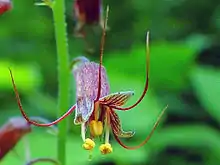Tolmiea menziesii
The plant Tolmiea menziesii (/tɒlˈmiːə mɛnˈziːzi.aɪ/)[1] is a member of the genus Tolmiea. It is known by the common names youth on age,[2] pick-a-back-plant,[3] piggyback plant, and thousand mothers. It is a perennial plant native to the West Coast of North America, occurring in northern California, Oregon, Washington, British Columbia and southern Alaska. It occurs as a naturalised plant or garden escape in Scotland, parts of Wales, Northern Ireland and northern and western parts of England.[4]
| Tolmiea menziesii | |
|---|---|
 | |
| Scientific classification | |
| Kingdom: | Plantae |
| Clade: | Tracheophytes |
| Clade: | Angiosperms |
| Clade: | Eudicots |
| Order: | Saxifragales |
| Family: | Saxifragaceae |
| Genus: | Tolmiea |
| Species: | T. menziesii |
| Binomial name | |
| Tolmiea menziesii | |
Description

Tolmiea menziesii has hairy, five to seven-lobed, toothed leaves and a capsule fruit containing spiny seeds
It bears many small flowers in a loose raceme. Each flower consists of a tubular purple-green to brown-green calyx and four linear or subulate (awl-shaped) red-brown petals, about twice the length of the sepals.
It has unusual reproductive habits. It grows plantlets from the petiole near the base of each leaf. The plantlets drop off, fall in the soil, and take root there.[5] It will also reproduce by rhizomes and by seeds.

Taxonomy
The genus was named after the Scottish-Canadian botanist William Fraser Tolmie, while the species name refers to Archibald Menzies, the Scottish naturalist for the Vancouver Expedition (1791–1795).
The plant was formerly considered to be the only member of a monotypic genus until diploid populations (due to autopolyploidy) were split off as a separate species T. diplomenziesii from the tetraploid populations.[6][7]
Cultivation
Tolmiea menziesii is commonly cultivated as an ornamental plant, for use as a house plant or planted as a groundcover in gardens.[8] It requires moisture and does not tolerate much sun or dryness.
References
- Sunset Western Garden Book, 1995:606–607
- "Tolmiea menziesii". Natural Resources Conservation Service PLANTS Database. USDA. Retrieved 11 December 2015.
- "BSBI List 2007". Botanical Society of Britain and Ireland. Archived from the original (xls) on 2015-01-25. Retrieved 2014-10-17.
- Blamey M, Fitter R and Fitter A; Wild Flowers of Britain and Ireland; London; 2003
- Yarbrough, J. A. (1936). The foliar embryos of Tolmiea menziesii. American Journal of Botany 23(1) 16-20.
- "Flora of North America". eFloras.org. Retrieved 2014-06-03.
- Soltis, D. E. and B. A. Bohm. (1986). Flavonoid chemistry of diploid and tetraploid cytotypes of Tolmiea menziesii (Saxifragaceae). Systematic Botany 11(1) 20-25.
- Las Pilitas Horticulture database: Tolmiea menziesii (Piggyback plant)